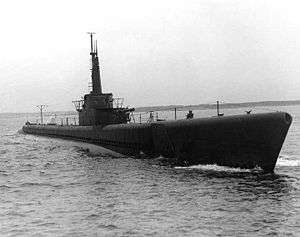USS Cisco (SS-290)
 | |
| History | |
|---|---|
| Builder: | Portsmouth Naval Shipyard, Kittery, Maine[1] |
| Laid down: | 29 October 1942[1] |
| Launched: | 24 December 1942[1] |
| Commissioned: | 10 May 1943[1] |
| Fate: | Sunk by Japanese aircraft west of Mindanao, 28 September 1943[2] |
| General characteristics | |
| Class and type: | Balao-class diesel-electric submarine[2] |
| Displacement: | |
| Length: | 311 ft 9 in (95.02 m)[2] |
| Beam: | 27 ft 3 in (8.31 m)[2] |
| Draft: | 16 ft 10 in (5.13 m) maximum[2] |
| Propulsion: |
|
| Speed: | |
| Range: | 11,000 nm surfaced at 10 knots (20,000 km at 19 km/h)[6] |
| Endurance: |
|
| Test depth: | 400 feet (120 m)[6] |
| Complement: | 10 officers, 70–71 enlisted[6] |
| Armament: |
|
USS Cisco (SS-290), a Balao-class submarine, was the only ship of the United States Navy to be named for the cisco, a whitefish of the Great Lakes. Her keel was laid down by the Portsmouth Navy Yard in Kittery, Maine. She was launched on 24 December 1942 sponsored by Mrs. A. C. Bennett, through her proxy, Mrs. N. Robertson, and commissioned on 10 May 1943 with Commander James W. Coe in command.[7] She reported to the Pacific Fleet.
Cisco sailed from Panama 7 August 1943 for Brisbane, Australia, arriving 1 September to assume local patrol duties, until 18 September, when she docked at Darwin. She put out on her first war patrol 20 September, but never returned. Japanese records tell of sighting a submarine leaking oil on 28 September in an area where Cisco is known to have been the only submarine then operating. Japanese records state this submarine was sunk by bombs and depth charges. Cisco is thus presumed to have been lost in action 28 September 1943. The only survivor from the crew was Chief Radioman Howell B. Rice (USN ret.), who was taken sick in Darwin and sent ashore to the Navy hospital prior to Cisco's final voyage.
Japanese records state that the submarine was attacked by Type 97 "Kate" attack bombers of the 954 Naval Air Squadron and the riverboat Karatsu (originally the U.S. Navy gunboat USS Luzon (PR-7), captured by Japanese forces and put to work against her former owners).[8]
References
- 1 2 3 4 Friedman, Norman (1995). U.S. Submarines Through 1945: An Illustrated Design History. Annapolis, Maryland: United States Naval Institute. pp. 285–304. ISBN 1-55750-263-3.
- 1 2 3 4 5 6 7 Bauer, K. Jack; Roberts, Stephen S. (1991). Register of Ships of the U.S. Navy, 1775–1990: Major Combatants. Westport, Connecticut: Greenwood Press. pp. 275–280. ISBN 0-313-26202-0.
- 1 2 3 4 5 Bauer, K. Jack; Roberts, Stephen S. (1991). Register of Ships of the U.S. Navy, 1775–1990: Major Combatants. Westport, Connecticut: Greenwood Press. pp. 275–280. ISBN 978-0-313-26202-9.
- ↑ U.S. Submarines Through 1945 p. 261
- 1 2 3 U.S. Submarines Through 1945 pp. 305–311
- 1 2 3 4 5 U.S. Submarines Through 1945 pp. 305–311.
- ↑ SS-290, U.S.S. Cisco
- ↑ 米潜水艦「シスコ」(USS Cisco SS-290,艦長J・W・コー少佐)、フィリピン沖で海軍第954航空隊(九七艦攻)、河用砲艦「唐津」の攻撃を受け沈没
- This article incorporates text from the public domain Dictionary of American Naval Fighting Ships. The entry can be found here.
External links
- Photo gallery of Cisco at NavSource Naval History
- On Eternal Patrol: USS Cisco
- Obituary of Howell Barbee Rice (1917–2011), sole survivor of the USS Cisco
Coordinates: 9°47′N 121°44′E / 9.783°N 121.733°E